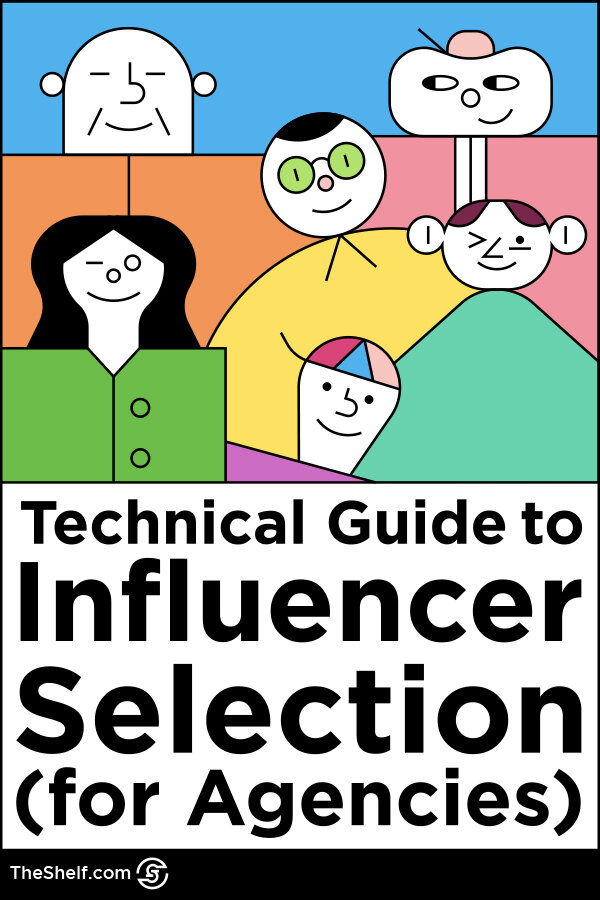Influencer selection can sometimes feel like speed dating where you’re constantly trying to see if you and the other person align with one another. You seek out influencers because they cut through the noise and help tell a brand’s story in a way that resonates with your target audience. With the transparency that comes with half the global population being on at least one social media platform, being able to successfully align with the right influencer for your brand has become absolutely crucial.
But it’s not easy. Influencer selection is one of the biggest hurdles for brands and marketers to overcome when it comes time to plan an influencer campaign.
50 percent of marketers have trouble identifying which influencers have a fake followers
38 percent of marketers are troubled by rising influencer costs
28 percent say maintaining brand safety and brand alignment is problematic, and
18 percent say they have trouble making sure sponsored content meets FTC regulations and requirements
Source: Mediakix
Influencers contribute to the overall narrative and conversation surrounding your brand. So, it’s critical that brand-influencer partnerships align in more ways than one. But not all of the influencers you find are made to meet the parents. This means that there is room to be picky as you take on the difficult task of finding the influencers that can help you share your brand’s message best.
Before you start dating your way to marketing bliss, let’s talk about the different types of influencers and what to look for when it comes to reaching influencer alignment (the marketing equivalent of enlightenment). You’ll learn how to diversify your selection to support your varying campaigns, along with how to build meaningful relationships with these individuals in ways that are scalable and effective.
What Is Influencer Selection?
Influencer Selection is a process of identifying the qualities and proficiencies an influencer needs to successfully help brands reach their marketing goals. Not all influencers will be a good fit for every campaign.
The influencer selection process is often easier when you have an influencer tool (like The Shelf platform). That’s mainly because it requires you to look at quantitative data about the influencer, qualitative data about an influencer’s content, and behavioral data about the influencer’s audience to determine if a creator has real influence with the audience the brand actually needs to reach.
Yah, it’s a lot. And it’s a pretty big deal for your campaign!!
The Different Types of Influencers
What are the different levels of influencers? The influencer marketplace breaks down into five influencer tiers - mega/celebrity influencers, macro influencers, mid-tier influencers, micro influencers and nano influencers.
Each type of influencer can support your efforts on multiple fronts. We actually did a pretty thorough breakdown in a recent post on influencer tiers, but just to recap...
MEGA/CELEBRITY INFLUENCERS (1M+)
These are the Beyonce’s and Kardashians of the social media sphere that are often household names. This tier is typically the most expensive and makes up a small fraction of the global influencer network. They also come with lower engagement rates since their audiences are so large. It’s a pretty sure bet that some people are just following the influencer because so many other people are following, and not necessarily because they have anything in common with the influencer.
While celebs may seem like the cream of the crop when it comes to enhancing your brand’s exposure, the numbers tell us that it isn’t so simple. A larger following doesn’t necessarily equate to a larger profit margin next quarter. Why? Well, because there’s more to influencer marketing than follower counts.
There are plenty of other factors and countless variables that can complicate the influencer selection process. 🙌 But these variables also deliver opportunities for brands to hyper-target their influencer campaigns.
MACRO INFLUENCERS (300K - 1M Followers)
We like to classify macro-influencers as those who are experienced and often create full-time or have some form of representation. They are often experienced and well-versed with the industry standards and what’s expected of both parties. This influencer tier is especially great for those who want to maximize their brand’s reach.
MID-TIER INFLUENCERS (50K - 300K)
The mid-tier is an in-between influencer that may be working toward becoming full-time, and often boasts higher engagement rates than their high tiered friends. You can expect these influencers to ask for more than a product exchange and they’re fairly familiar with the industry.
MICRO INFLUENCERS (5K - 50K)
The micro influencer tier is where you’ll see a more diverse range of experience among influencers. Some may be pricey and experienced while others may be less familiar, charge less, or place a higher value on getting free products to supplement their rates, which generally start around $50 per post . One of the great things about micro influencers is they typically have higher engagement rates, making them a good investment if your goal is to get audience members to take action.
The industry has already caught on to the potential of influencers with smaller followings, which is why Influencer Marketing Hub found that there was a 300 percent increase in the number of micro-influencers used by large firms from 2016 to 2020.
NANO (1K - 5K)
Nano-Influencers pose an interesting opportunity as many know their followers in real life and typically have larger engagement rates. While you want to be sure that there is an intent to influence, this tier can be extremely beneficial to your marketing efforts as the level of trust between the influencer and followers can often be higher.
Harsh Reality: Catfishing is a Thing
We have to be honest, but there is always a chance that the influencer isn’t entirely real. There are bots and fake accounts that don’t actually offer real influence, but maintain the illusion as bait. Working with a well-developed influencer platform or agency (pointing to ourselves over here) can aid you in this process along with being methodical and critical in your search.
What to Look for In an Influencer
So, now we know who’s who. Awesome. Now, how the heck do you whittle down a pool of 50 million influencers so that you can separate the people with large followings from creative partners who can actually get their sizable audiences to take actions on your behalf?
I’ll tell ya.
Your influencer selection process will be dictated almost entirely by your campaign goals. What do you want to accomplish with your campaign? Why are you choosing now to run an influencer marketing campaign? If you want to get more app downloads, then you might opt for micro influencers who have higher engagement rates (comments, saves, sticker taps - not just likes). And maybe loop in a higher-tiered influencer who can get more eyes on your product to boost your brand awareness.
Or maybe you want to establish thought leadership, which could involve prioritizing influencers that directly align with your niche or who have experience with your industry.
Or, you can diversify by expanding your target audience and looking to engage new markets - introducing single men to a super-fancy dog food or getting busy moms to switch vitamin brands, even though doing so would end up being an inconvenience for her at first.
Whatever your goals are - whether app downloads or mom vitamins - they determine which qualities would make up the “perfect influencer” for your campaign.
Streamlining Your Influencer Selection Criteria
Whether you hire an agency, use an influencer marketing platform, or create your own system, there is a need for alignment between your brand (product, voice, values, message) and the influencers you select. It’s not just about high follow rates. Even though the macro and mega influencers have a massive followings, adding “celebrity” to your lead growth campaign for your software company doesn’t necessarily translate to big bucks, even though doing so could make your campaign more memorable.
It’s not just relevance and context, it’s more like synergy. We know, it’s the buzzword you can’t escape. It’s building harmony between two parties who are working together to share a message.
Just as you might be familiar with building out personas for your customers, it can help to take a similar approach for your influencers. How old are they? Do they have a family? How often do they post? What do they like to do for fun? Have they recently become freakishly good boxers?
So, let’s streamline the influencer selection process by identifying your influencer selection criteria. These are the data points you need to know to make influencer matching data-driven.
Gather Demographic Info on Influencers
Most macro influencers and many micros will already have an influencer media kit that provide brands with information about the influencer’s reach, engagement ratios, blog traffic, and audience size. But you also need a significant amount of data on the influencer that typically falls under the heading of demographic/quantitative data.
Age
Gender
Marital status
Family size
Race/ethnicity
Background
HH income
Location
Language
Include Performance Data
In addition to identifying the type of person you want to bring in for your campaign, it’s also a good idea to make sure the person wants to be an influencer. This is especially true of nano influencers who may just be super likable and grow followers quickly, and not necessarily interested in becoming influencers.
Performance data is an important part of the influencer selection process, and aside from just talking to influencers to find out if they’re interested in your campaign, you can also find out a great deal of info ahead of time by looking at performance data.
Follower count
Reach (because algorithms show the content of creators who have engaged audiences)
Engagement ratios
Types of engagement (likes vs comments vs saves vs sticker taps vs swipe-ups)
Platforms on which influencers are most active
Topic, quality and frequency of posts
Previous partnerships
Authority
Don’t Forget About the Quality of the Content
A lot of marketing teams would stop there and use the qualities listed above as the criteria around which they build their entire influencer campaign. But there are also qualitative markers that will be crucial to creating a sticky campaign that resonates with consumers.
Storytelling
Aesthetic
Quality of content
Audience sentiment
Level of creativity
Values
Relatability
Influencer personality
Lighting
How they engage with followers
It’s not a perfect science, and includes reviewing data that’s both quantitative and qualitative. Just as you want to pay attention to engagement rates, location, age, and budget, you also want to consider their overall aesthetic, content quality, and values. You might conduct some research into their work or even look to their other partnerships to help you discover whether your brand would make sense with their overall message.
While spreadsheets can help (and we definitely use spreadsheets when it comes time to calculate influencer rates - or what we think they may end up being), there’s a level of critical review that feels more holistic as you find the right partnerships. Below is a recommended list of factors to consider for each influencer.
Effectiveness and Actual Influence
The influencers you select need to be able to craft targeted sponsored content that can reach the specified audience. Be mindful of the influencer’s skills and where they shine, meaning that if they specialize in makeup flat lays for Instagram, you wouldn’t want to ask them to create a video of them using the products on YouTube or TikTok. Understand their style and imagine if your brand and messaging can fit in with their content in a way that feels seamless and in line with their current work.
Analyze Audience Behavior
This is a BIG one, and too many brands skip audience analysis at the expense of their campaign ROI. The reason influencer marketing continues to grow is because of how it can influence behavior. If you don’t have a creator who can influence the behavior of their audience, we don’t actually call that an influencer. Or it may just be that the influencer is only influential when it comes to certain topics.
Like what kinds of hashtags do they use? What kinds of emojis do they use (there is such a thing as boomer emojis). What kinds of brands do they post about? What kinds of brands do they wear? Mention? You can often tell if an audience skews young or if it comprises a segment that would respond to different messaging or a different product altogether.
Take note of how their audience interacts with the content for insight into the type of individuals involved. Everything from hashtags to the jokes they make can help you understand information like age or other interests.
The influencer’s followers need to be engaged and match your brand’s target audience or your message may fall into the online void of doom.
It’s also important to remember that influencers have a checklist they’re running through on their end to determine whether the brand is a good match for them and their personal brand. Consider micro influencers like Sophia (@svvphia). When asked what she looks for in brand partnerships Sophia said:
“It’s always great partnering with brands I feel I really align with, especially those whose philosophy revolves around reducing their carbon footprint, commitments to giving back to their community and diversity (in the workplace and the creators they collaborate with), using durable and smart packaging, and price points that reflect the above.”
The perfect influencers for your brand and specified campaign are out there, it’s just a matter of alignment.
Practice What You Preach
Influencers work pretty hard to build their brands and their audiences, so they’re super particular about the brands they choose for partnerships. For an influencer, being connected to a brand that’s fallen from grace or that says and does things that fall outside of the influencer’s value set is the fastest way to losing followers and future partnership opportunities. If you’re a brand like Fenty Beauty that prioritizes inclusivity, then your partnerships should match your values.
Companies like Merit Beauty focus on minimalism when it comes to their makeup collection, and their influencers typically showcase a similar aesthetic to ensure consistency and synergy within the partnership. Both parties need to be firm in who they are and what they stand for to ensure the longevity of their alignment.
How Do You Choose an Influencer?
You might be thinking “Okay, I get the gist, now how do I do this?”
There are multiple approaches as to how you access or select your influencers, sometimes from a specific pool. You might use an influencer marketing platform, where the selection is curated by a third party into a network. Opt-ins are another option that allow influencers a chance to respond or apply for the opportunity.
Agents can be a way to work with one professional that represents a variety of influencers for easy communication. We’ve worked with tons of agents to negotiate the terms of an influencer’s participation in a campaign. Tends to be a little pricier, but some creators are absolutely worth it.
You can also create your own influencer outreach strategy (👈this link goes to a post that includes templates, too - just an FYI) to contact influencers. But I’ll say this: Using a platform can save you time and energy as you can usually narrow down your search and apply filters for a quicker selection process.
Before you reach out to influencers, you want to be sure you are professional, relatable, and clear on what you’re looking for. And that the influencer is a reasonably good match for your campaign. Influencers hate it when brands reach out blindly, without bothering to do any research ahead of time.
If the opportunity feels too open-ended or doesn’t make sense for what the influencer does, you might find yourself in a string of rejections that never make it to that first date (call back to our earlier dating reference).
Just as there is a funnel for consumers as they become customers, you may take a similar approach to influencer matching and relationship building. Some may feel like a long-term strategy where you’re warming them up to become brand advocates as opposed to hitting KPIs in the short-term with a one-off campaign.
How Do You Identify Potential Influencer Partners? Focus on Relationship Building
For those looking to take on the long-game with their favorite influencers, be sure to focus on how you can build a meaningful relationship. Flattery will get you everywhere in life, but not if it’s lacking in heart and doesn’t feel real. Don’t just comment “cool,” on all their posts. Get specific and determine what it is about the influencer that attracts you and your team and how this aligns with the brand and be willing to share your genuine thoughts.
If you’re just starting your outreach program, consider looking to the types of influencers that are already obsessed with your brand. Your number one fans pave the way for the types of loyal partnerships that will help your influencer marketing strategy.
Searching for Influencers in Your Niche
Google Alerts and exploring hashtags can help you find influencers as well. Starting conversations and building relationships organically can take more time, but can also help you be more thorough as you’re vetting influencers so you get a feel for who they are beyond vanity metrics like follower counts and Likes. Some may even set up interviews or work to create more involved partnerships depending on your brand’s values and needs.
As an agency, there can be a lot of people working behind the scenes for a campaign. Try to ensure that each influencer you select has one point of contact to minimize confusion and enhance the relationship for both parties. Be mindful about the types of relationships you want to build, as you may seek out both short- and long-term influencers to work with, depending on your campaign goals and your influencer selection process.
Consider casting a wide net, as not every influencer may be jumping at the opportunity to work with you. It’s a hard pill to swallow, but the truth is that these partnerships should benefit both parties.
Not everyone is going to love you, but the ones that do are going to be able to share their authentic experiences in a genuine way with their followers, which is what you want. Try to welcome the rejection. It helps you get one step closer to that perfect match.
Refine Your Process
Your system will probably evolve as you start to complete and track your campaign efforts. Your should routinely update your pool of influencers as you track campaign progress and document their performance. Be mindful of feedback as you work with your team and partnerships to help you adjust your system as needed.
Your campaigns are going to change with the needs of the brand, which means you are constantly selecting influencers. You want to stay open to new people and opportunities that can help you routinely meet your campaign goals, and sometimes the influencers from your last campaign are not going to be the best choice.
Be sure to document progress, concerns, and more with each influencer to help you determine if you want to continue working with that person or if you’d rather bring in someone new for the next campaign.
Treat Influencers as More Than a Number
While influencers are a hot commodity for everyone’s marketing efforts, they also don’t always like to be treated like just a number. As you build and foster these relationships, consider small adjustments you can make at the beginning of your selection process that can help the partnership feel more special and intimate. This can encourage more interest on the influencer’s part as they can feel more invested as you interact with them as a representative of the brand.
If the budget doesn’t allow for additional gifts or more pay, look to hand written notes or kind words in your interactions to deepen their emotional connection to the brand.
Final Thoughts on Influencer Selection
Remember, falling in love takes time. Your approach is going to have a significant impact on how the influencer views the brand, and you want them to fall madly in love. Focus on consistently nurturing the relationship to help breed better content for the brand. Love doesn’t always happen over night, but keeping all of the above in mind can lead to harmonious partnerships.

So we analyze everything from follower count to favorite platform to family life to brand affinities to determine exactly who would be the best creator to get your audience to take specific actions.
SCHEDULE A STRATEGY CALL
Or click below to call
(212) 655-9879








